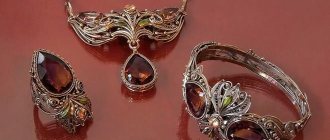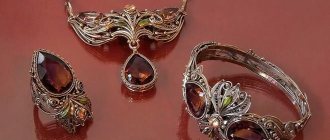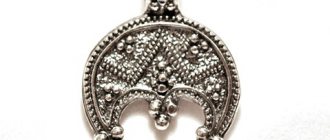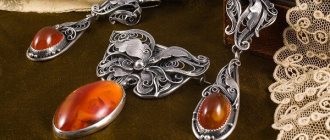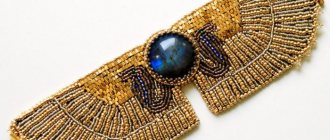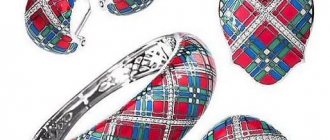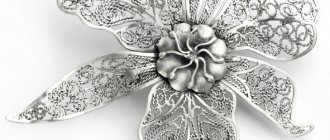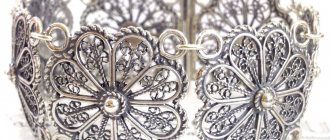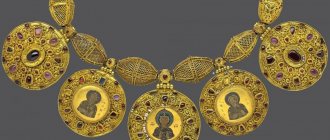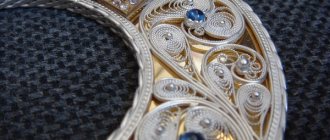People have always decorated themselves. The first human jewelry was made from bones, teeth or animal horns, shells, pieces of wood - and what a person put on himself did not just decorate him, but protected him, protected him, gave him luck in hunting, bestowed wisdom and even elevated him above other members tribe. Thus, the history of jewelry is also the history of magic.
The most ancient jewelry was found in southern Africa; its age is about 75 thousand years - these are beads made of shells, painted with red clay. The shells were carefully selected in size and shape and probably symbolized the high status of their owner.
What is filigree and filigree?
Filigree and cloisonne enamel
In jewelry, filigree and filigree mean the same thing; it is openwork weaving made of thin wire. Craftsmen created both individual products and jewelry from wire, and used openwork weaving to decorate ready-made jewelry. “Skan” is a purely Russian word and it means “to twist, weave threads”; the word “filigree” came to us from Europe and means “thread”, “grain”.
It is interesting that in Russia and Europe this jewelry technique began to develop separately, but in its technology it turned out to be almost identical, the only early difference was that French masters were the first to use precious stones as inserts into jewelry, Russian masters used filigree together with cloisonné enamel _
But historians have found the homeland of filigree - ancient Egypt and Greece; during excavations of ancient cities, archaeologists found jewelry and household utensils with patterns made with wire, the age of the find is the 6th century. BC.
Primitive jewelry
Unfortunately, history has brought to us very little of the jewelry of our ancestors - bone, wood, teeth and claws of animals are poorly preserved, and only stone, and then metal, were able to survive and give us the opportunity to find out how the art of jewelry arose and developed.
So, at first man used stone only in the form in which he found it in nature. He was attracted by the shine and shape of the crystal, and later he learned to refine and process stones, thereby laying the foundation for the jewelry business. The skills of working with stone appeared about a million years ago. At that time, man (Homo Habilis, Habilitative Man) already knew how to make primitive tools from flint and obsidian, and then this art reached extraordinary heights. It is still not entirely clear how ancient man, having no tools other than stone, horns and animal bones, could make such wonderful, ideally shaped arrowheads or spears!
Filigree in ancient Rus' - from solid technology to openwork
Filigree art became widely known in the 2nd century. BC. In Kievan Rus, filigree art was first mentioned in the 9th century; craftsmen used a blind technique, when twisted wire was soldered on top of the decoration. Mobile and grain were more common in those days. Masters from Chernigov were engaged in blackening silver and gold, gradually spreading their art throughout all Russian principalities.
Russian filigree subjects depicted nature, fairy-tale characters, and original utensils. With the beginning of the flourishing of trade in Rus' with Byzantium, oriental motifs and the authenticity of Europe and Asia were introduced into the technique of openwork filigree. Antique buttons decorated with openwork mesh have been preserved; the master’s fine work fascinates even 800 years after the filigree was created.
The flourishing of technology occurred in the 18th-19th centuries, at this time masters created masterpieces of filigree art, filigree technology was presented by masters from Latin America, Europe, and Russia, jewelry made of precious metal and iron amaze with its beauty and uniqueness.
What is remarkable about silver in the history of jewelry?
Silver is the second precious metal with which man became acquainted, and it is also very ancient: products made from it appeared already six thousand years ago. Silver is a feminine sign, a symbol of the Moon . This metal has antiseptic properties, so many amulets and protective signs have always been made from it.
Silver is harder than gold, but under the influence of the environment it gradually darkens, and it must be cleaned from time to time. It is also often used in alloys.
Silver, like gold, occurs in nature in the form of nuggets. In ancient times, these metals were mined mainly in Egypt, Spain, the Caucasus (here was the same Colchis, familiar to us from the works of the ancient Greeks), Altai, America, India and China.
What is filigree in the USSR
During the Soviet Union, filigree as a folk craft and jewelry art was recognized as a state and national treasure, so the technique continued to develop. In 1930-37, the Veliky Ustyug and Kostroma workshops received the highest awards at international filigree competitions. Today, filigree continues to develop; in Russia there are several dozen workshops that produce exclusive, unique jewelry and household items.
The famous Krasnoselskaya filigree created a worldwide sensation at the Paris Exhibition in 1937. Success was repeated 2 years later in New York.
Kazakovskaya filigree
Today, the Kazakovsky Art Products Enterprise (KPHI) is a serious brand (website kphi.rf), specializing specifically in products using this technique. Cossack craftsmen make jewelry from silver and silver alloy, steel and gold. The Cossack technique is easy to distinguish from other schools thanks to the finest wire pattern.
The artist-jeweler pays great attention not only to the overall pattern of the decoration, but also to the pattern of the gaps, forming unique samples of products, each of which can be called a work of art.
Filigree Kubachey
Kubachi jewelers (kubachi.su), along with the traditionally famous Dagestan technique of blackening, chasing and engraving, also produce filigree items of incredible beauty. Jewelry and household items of the Kubachi are produced to order and in a single copy, each figurine is made of silver, often the decoration is complemented with blackening and granulation.
Today in Russia several centers and schools are productively operating, where young jewelers are taught filigree techniques. In the Nizhny Novgorod region, these are the Pavlovsk College of Folk Crafts, the Kazakovsky Center at the enterprise of the same name, and the Krasnoselskoye School of Artistic Metalworking in Kostroma.
Wearing rules
Most people who are not collectors purchase antique gold jewelry for personal use. It is worth noting several unspoken rules for wearing such products:
- It is not recommended to mix metals. For example, if your choice fell on a silver ring, a brooch or earrings should be purchased from the same metal.
- It is important not to mix products from different eras; if in doubt, you should give preference to only one piece of jewelry.
- When choosing a massive piece of jewelry, you should emphasize its uniqueness with a simple cut of clothing.
The most important thing in wearing antique jewelry is its appropriateness in this case, because a massive necklace or brooch will look ridiculous in the office.
Filigree technique - main directions
There are several dozen techniques that allow you to diversify classical filigree: masters use stones, niello , and combine filigree techniques. The three most common areas remain:
- soldered filigree;
- volumetric;
- openwork.
Each jewelry technique is beautiful and unique in its own way.
Soldered filigree
With this technique, a wire pattern is soldered onto a base, household item or decoration. Often brazed filigree is used together with cloisonné enamel and stone inlay. According to the technique of execution of the pattern, brazed filigree is divided into sawn or perforated filigree, in which the pattern is cut out from the base, blind filigree, when the openwork pattern is prepared separately and soldered to the base, and the cloisonné enamel technique.
The filigree cutting technique was very popular in medieval Europe; in Russia they preferred openwork filigree or cloisonné enamel.
Openwork filigree technique
The name of jewelry art speaks for itself: wire is used to form a piece of jewelry that has no base. The pattern is attached to each other by soldering; granulation is often used in the openwork technique - metal balls are soldered into the lace. In most variants, flat patterns are made using the openwork technique.
Volumetric filigree
Jewelry and household items made from voluminous filigree attract the eye with their beauty and airiness. It takes a lot of time and a lot of experience to make the smallest piece of jewelry. The technique is based on openwork weaving, which bends during the manufacturing process and follows the desired contour.
The filigree technique of precious metals can create colorful combinations with various materials: precious and semi-precious stones, enamel, blackened silver, glass and wood.
Where can I buy?
Buying antique jewelry in Moscow will not be difficult, because in the capital there are many antique shops, auctions, and shops. In smaller cities this is more problematic, but here online stores will come to the rescue, sending the item you like to any part of the country and beyond. However, it is important to carefully check the seller or marketplace before purchasing. Today, instead of genuine antiques, there is a risk of getting a modern fake of good quality if you do not check the relevant documentation.
In addition, at flea markets you can sometimes find a unique item, the cost of which will be an order of magnitude lower than in the store. However, even here, without careful checking, you can buy antique-style items.
Metal for filigree
Craftsmen made the first filigree jewelry from gold and silver; noble metals were chosen based on the main feature - softness. In addition, gold is a fairly fusible metal; the jeweler heated the ingot and pulled a wire from the metal, which was easily twisted.
Silver is also a low-melting metal; silver threads of various thicknesses were drawn from the ingot, pressed and twisted into a spiral. For example, from one gram of gold you can get a thread 25 meters long.
In addition to being easy to process, precious metals themselves have a high value; items made of gold or silver filigree emphasized the status of the owner, were always made to order and were expensive. In the 17th century, blacksmiths and jewelers began to use iron and various alloys of simple metals for filigree; jewelry had high value as a product, but had no value based on the type of metal.
Russian jewelry art of the XII-XV centuries
Russian jewelry art, presented in the first hall of the Armory, covers the period from the 12th to the beginning of the 17th century. Russian goldsmiths in Kievan Rus mastered the same techniques and techniques for processing precious metal that were used by craftsmen in Western Europe and Byzantium. These methods penetrated into Rus' through trade and diplomatic ties. But not many monuments of ancient jewelry art have survived from the times of Kievan Rus. Some items were found during archaeological excavations, others are accidentally discovered treasures. The basis of the Armory Chamber's collection is products of Russian masters of the 16th-17th centuries.
Table of contents
Showcase 2. Russian gold and silver items of the 12th-15th centuries. Russian jewelry art of the XII-XV centuries
The most ancient Russian monument of the 12th century is a silver bowl. It belonged to the Chernigov prince Vladimir Davydovich.
This form of product has existed in Rus' since the 10th century. The only decoration on it is the inscription by which the owner of the bowl was identified. The cup was intended for drinking in a circle, when everyone, as a sign of belonging to a family or squad, drank a little from the filled vessel and passed it on to another. When the cup went around the full circle of those gathered, all participants in the feast became “brothers.” Later, such bowls began to be called “brothers”.
The cup of Vladimir Davydovich lay in the ground for many centuries. In 1852, it was found on the site of Saraya-Batu, the former capital of the Golden Horde Khanate on the Volga. Until now, historians have not been able to figure out how the bowl ended up in the Sarai. Perhaps the Polovtsy captured it during one of the raids on Russian soil. But it is possible that the cup has nothing to do with the military raids of enemies. The wife of Vladimir Davydovich, who was killed in an internecine war, remarried the Polovtsian Khan Bashkord. It is quite possible that the cup was part of her dowry. It is also worth noting that the Chernigov prince Vladimir Davydovich himself was the cousin of Prince Igor, the hero of “The Tale of Igor’s Campaign.”
Women's jewelry. Temporal rings. Russian jewelry art of the XII-XV centuries
The exhibition presents women's jewelry. Very often such decorations made up the entire treasury of the family. The most common women's jewelry is temple rings, for attaching to a headdress.
Most often, they were attached to a ribbon and the ribbon, already folded in two, was sewn onto the sides of the headdress and hairline. Most often, the temple rings were made in the shape of a five-rayed star. The smallest balls, with a diameter of 0.04-0.05 cm, were placed in a ring with a diameter of 0.06 cm. In total, there are up to 5,000 such silver grains on each of the decorations. The technique of soldering myrcoscopic rings was well known in pre-Mongol Rus'.
Chalice. Russian jewelry art of the XII-XV centuries
The masterpiece of the collection is a silver chalice made by Vladimir-Suzdal craftsmen. This is a very slender bowl with proportionate parts.
One of the medallions decorating the chalice contains an image of St. George. The chalice comes from the Transfiguration Cathedral in the city of Pereslavl Zalessky. Therefore, historians believe that the chalice most likely belonged to Yuri Vsevolodovich, the grandson of Yuri Dolgoruky.
Ryazan treasure. Russian jewelry art of the XII-XV centuries
The famous Ryazan treasure is apparently part of the grand ducal treasury, which was hidden during the siege of the city by Batu’s hordes in 1238. When the peasants were plowing the field in the spring of 1822, they found a pot of jewelry. The vessel was hit by a plow, it broke and the rare objects of pre-Mongol jewelry displayed in the window rolled out of it.
Barms and Colts
The treasure includes symbols of the grand ducal power - barma.
Colts were also among the items found. The technique used to decorate these jewelry is cloisonné enamel, filigree, and precious stones. Historians still have not figured out the purpose of the Colt. One might assume that this is a woman's jewelry, but each disk weighs 400 g, for a total of 800 g.
Therefore, it is difficult to imagine that a woman could wear such heavy jewelry. Maybe the kolta were a decoration for the icon frame.
Filigree and filigree. Russian jewelry art of the XII-XV centuries
Colts and barms are decorated with the finest gold lace – filigree. Filigree is the laying out of patterns with gold thread on a metal surface. The ductility of gold made it possible to draw a thread up to 2 km long from 1 g of metal! Then the gold wire was rolled through a special roller and a flat ribbon was obtained. It was placed on its edge and patterns were laid out in this way.
In Rus', this technique was even more complicated, because the gold ribbon was additionally twisted like a rope. That’s why the Russian filigree technique is called filigree, from the words skat, twist, twist. The patterns were quite convex, because the filigree was laid in several layers.
The kolta depict the first Russian saints Boris and Gleb.
On the bars in the center there is an image of the Mother of God, on the sides are Saints Irina and Barbara. The images of saints are made using the cloisonné enamel technique.
Cloisonne enamel. Russian jewelry art of the XII-XV centuries
First of all, a design was applied to a gold or silver surface with a sharp object. The contours of the design were reinforced with gold tape and then filled with enamel in several stages. Enamel is a glassy mass to which oxides of various metals are added. Initially, the enamel has the appearance of a powder. The cells were filled with this powder and the product was fired in the oven. The enamel melted and shrank. Then more powder was added and burned again. The procedure was repeated several times until the enamel rose to the height of the pattern walls.
Colts and barmas are decorated with gems planted in high sockets. The methods of strengthening stones on a gold surface indicate that Russian craftsmen knew European techniques for working with stones and successfully applied them.
Novgorod chalice
Another chalice in the museum’s collection is the work of a Novgorod master. In the northern regions, the traditions of jewelry art were not interrupted by the Mongol-Tatar invasion. But the Novgorod and Pskov goldsmiths were well acquainted with European jewelry art. Russian craftsmen have ALWAYS made chalices from precious material. The Novgorod chalice is made of agate-like jasper, so we can assume that it is a Western European work.
But studies of the chalice showed that it was worked by a Russian master. The top of the bowl is decorated with the finest filigree in the form of an infinity sign and stones.
The Ark is a quadriforium. Russian jewelry art of the XII-XV centuries
The Ark is a quadriforium. From a jewelry point of view, the ark is decorated using a very complex technique. Some parts are decorated with a black pattern and it may seem that this is a niello technique. But this is not so, the ark is decorated with enamel. (Currently, the quadriforium is located on the first floor of the Armory, in a display case with royal regalia).
Showcases 3 and 4. Moscow jewelry of the 15th century. Russian jewelry art of the XII-XV centuries
At the end of the 14th century, politically, Moscow rose above other Russian cities, but a single, special, Moscow style had not yet emerged by that time. Moscow masters still turn to examples of Kievan Rus.
Until the 18th century, there were no known deposits of precious stones in Rus'. They were brought from Europe and the East. Russian craftsmen did not cut gems, but polished them; such stones are called cabochons (from the French caboche - head). Russian craftsmen valued stones as they came into their hands, as nature created them, sometimes with many flaws - chips, notches, irregular shapes. But if an already cut stone was brought to us, then it was used as is, with a cut. In Europe, master cutters lived in Amsterdam ; since time immemorial, the city has been famous for its lapidary workshops and jewelry making.
Folding.
Folder . It’s amazing that the thing is signed, it’s absolutely incredible for 1412. However, the name of the master is written on the folding - Lukean. The plot of the story is a song of the triumph of the Resurrection; Christ is depicted in heaven along with the saints. The influence of the Romanesque style is very noticeable in this work. A tiny thing is distinguished by amazing workmanship. Silver, gilding.
Setting for the Gospel of 1415
Setting for the Gospel of 1415 . Gold. Researchers associate the restoration of the salary in the 17th century with the name of the boyar Boris Ivanovich Morozov, the educator of Tsar Alexei Mikhailovich, which is why this salary is called the “Morozov Gospel”.
The decorations are made using embossing and filigree techniques. In the center of the composition is the scene of the Descent into Hell. The church fathers are depicted in the corners: including John Chrysostom and Basil the Great. Selected saints are placed along the field of the frame. Chrysoprase, emeralds, sapphires and amethysts decorate this setting. The book block inside is also very beautiful, with miniatures, but in very poor condition. There is currently no way to restore it. The illustrations on the parchment pages of the New Testament are close in style to the work of Andrei Rublev.
Settings for the icon of the Virgin Mary of Vladimir. Russian jewelry art of the XII-XV centuries
Setting for the Vladimir icon . The museum contains three frames for this icon. Two jewelry decoration techniques are used here - embossing or basma and embossing. (By the way, Boris Godunov’s throne was made using the basma technique). At the top of the frame there is an embossed Deesis. Embossing gives greater relief to the figures with a relatively small weight of the product, so using this technique the craftsmen achieved savings in precious metal. A few gems frame the face of the Virgin Mary, to which the worshipers addressed themselves.
Another setting for the Vladimir icon comes from the Assumption Cathedral of the Moscow Kremlin.
This is the contribution of Metropolitan Photius. Metropolitan Photius was a Greek, he came to Moscow in 1410 and brought with him a lot of Greek masters. The stamps are made using the embossing technique. The frame is decorated not with filigree, but with filigree. On the frame we also see a stamp with the name of Photius himself. (Enlarged fragment).
Continuation of the topic “Moscow jewelry art of the 15th century in showcase 4. Between showcases 3 and 4 is the Cradle of Alexander I. A story about it in a separate article.
Salary for the Gospel
Another setting for the Gospel is decorated with the finest filigree on a silver frame. On five narrow silver plates, a carved black inscription in script informs that the frame was made under the Grand Duke Ivan Vasilyevich and his grandson Dmitry Ivanovich at the behest of Metropolitan Simon for the Assumption Cathedral of the Kremlin. This is the work of the masters of the Moscow Kremlin. A continuously flowing ribbon of filigree fills the entire surface of the frame.
In the same work, the masters used another technique - gold casting. The crucifix and figures of saints are cast and soldered onto the surface of the frame. They are set off by the dense green enamel of the background.
Greater and Lesser Zion
Unique exhibits in the collection are two zions - large and small. The Great Zion is very reminiscent of the decorations of Romanesque and Gothic churches - architectural monuments of this era very often included sculptural images of saints. Little Zion is gilded, similar in shape to one of the churches of the Russian north, there is some similarity with the Nativity Church of the Ferapont Monastery in the Vologda region.
Zion the Little
Apparently, the zions were carried out during the solemn service, as symbols of the Church.
Additional information: gold and silver are malleable and fusible metals, which allows craftsmen to make items from them that are difficult or impossible to make from copper or modern alloys. There has always been little gold in Europe. Most of this precious metal was mined in Egypt. One of the ancient books even mentioned that there is as much gold in Egypt as sand in the desert.
Sources:
1.Lecture hall of the Moscow Kremlin. Lecture “The Art of Russian Goldsmiths of the XII-XVII Centuries. Senior Researcher Natalia Aleksandrovna Grigorieva. 2. Methodological recommendations for preparing a sightseeing tour of the Armory Chamber. Compiled by: Filatova T.V. 3. K.V. Donova, L.V. Pisarskaya “Armory Chamber”, M., Moscow Worker, 1960 4. I. Nenarokomova, E. Sizov “Artistic treasures of the State Museums of the Moscow Kremlin”, M., Soviet artist , 1978 5. I.V. Faizova “Methodological recommendations for a sightseeing tour of the State Armory Chamber of the Moscow Kremlin, M., Sputnik, 2011
Continued in articles: Russian jewelry art of the 16th century Russian jewelry art of the 17th century. We also recommend reading the articles: The Cradle of Alexander I, as well as a series of articles about Easter gifts made in the jewelry workshops of Carl Faberge. The first article in the series is “The history of the Faberge Easter egg collection .
Scan - history of art
Jewelry masterpieces created using the filigree technique existed before our era. The difference with the filigree of Ancient Rus' is determined by the method of producing wire from precious metals or alloys. They forged the wire or pulled the workpiece through a drawing device - the result was a thin jewelry thread. In Ancient Egypt and Greece, forging was used to make it.
Old Russian masters of the 10th century produced filigree silver and gold using the second method - drawing. What is filigree made many centuries ago is best seen in museums. They contain magnificent examples of princely household items and church utensils, decorated with fabulous ornaments. Clothes (boots, belts, etc.), book covers, dishes, crosses - filigree patterns bloomed everywhere. It is worth recalling that Monomakh’s hat is also decorated with filigree.
and without impurities, metals are easily drawn into wire. For example, a thread that can be made from 1 gram of gold will be about 2500 meters long.
Mastery of working with gold
Gold is a malleable and plastic material, which is extremely important when creating jewelry. Even the ancient Egyptians knew how to give it different colors using alloys with other metals. The peoples of Western Asia could forge gold into the thinnest sheets up to 0.03 mm thick (the so-called gold leaf technique), and the Greeks could stretch a piece of gold into a wire several kilometers long.
It is interesting that with all this, gold is a soft material, slightly harder than a nail. Therefore, in order to make it mechanically strong and avoid scratches and dents, which we see, for example, in ancient Greek jewelry, it was used in alloys.
Scan - types of weaving
The main elements of a filigree pattern are weaving, cord, rope, satin stitch and track. The lace applique is created from wire and resembles real lace from craftswomen. Grains and balls inserted into decorations add originality to the product. With the reduction in the cost of production, in addition to gold and silver, nickel silver, brass and copper began to be widely used in the Russian filigree technique.
The false filigree technique, in which the jewelry is not woven from wire, but is made by casting, helps to further reduce the cost of products. An alloy is poured into the finished mold, which forms the basis of the decoration. Cast filigree differs from real filigree in that the pattern has no relief and has a smooth shape, there are no transitions or thickenings, and no soldering spots are visible.
If you liked the article, share it on social networks. This is important to us, thank you
Tags: filigree in ancient Rus' - the basics of jewelry technology, What is filigree
How to choose
When choosing antique jewelry, you should pay attention to the following recommendations:
- The product must contain elements of style that were characteristic of a particular era. If the description of the jewelry indicates one historical period in which it was made, but the appearance speaks of something else, then most likely it is a fake.
- Antique jewelry cannot be cheap, especially if the exact names of the jeweler and previous owners are indicated.
- When purchasing, you can ask the seller for an expert opinion on the value of the metal and stones that were used in the product. If the purchase is made in an online store, the administration must send scanned copies confirming the authenticity of the jewelry.
When choosing a piece of jewelry as an adornment, you should listen to your own feelings when examining one or another option.
Reviews of purchases
People who take the risk of buying a unique antique item are often satisfied and even proud of owning an interesting item. Antique jewelry often becomes personal talismans that bring good luck, or heirlooms that are passed on to subsequent generations.
As a rule, antique jewelry is purchased by those who want to look status-conscious and original (and can afford it), because an exquisite item adds charm to an image, makes it unique, and can also raise self-esteem and mood. The main thing is that the purchase is meaningful and carried out competently.
